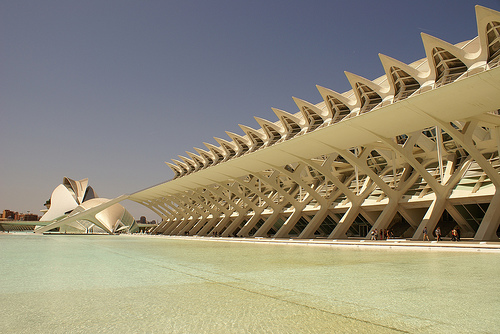 I’ve seen many photographs of Calatrava’s City of Arts and Sciences and it’s always the beautiful compliment of architecture and engineering that strikes me.
I’ve seen many photographs of Calatrava’s City of Arts and Sciences and it’s always the beautiful compliment of architecture and engineering that strikes me.
The two can often oppose one another, but this work had always seemed, from photographs at least, to have achieved a respectful balance, perhaps due to Calatrava’s own mastery and understanding of the two disciplines.
And indeed, when you first wander around it’s this technical precision that captivates. The symmetry, the natural forms, the sheer futuristic, shimmering whiteness of the place. It is truly a marvellous sight.
Once the architectural amazement has subsided however, an unexpected presence begins to make itself felt. The old Turia river bed.
I’ve always loved cities with rivers. They can lend an openness and a freshness to a city that would otherwise be rendered claustrophobic and introverted were it not for that expanse of water flowing through it.
A river is always a refuge in a city. A place to go to when you need to see sky, feel space, breathe a little.
However, they can also be a very unforgiving forces of nature, and in Valencia’s case, after a particularly disastrous flood in 1957, the local authorities decided to redirect the Turia river.
Thankfully, in an inspired piece of urban planning, the 9 kilometres long exposed riverbed was not developed with the usual housing and offices but was given over to gardens and to public space where Calatrava’s City of Arts and Sciences now stands.
Wandering through the gardens, the presence of the river is not as evident as you would imagine. Cities as hot and dry as Valencia seem to have a particular yellowy dustiness about them that can create the impression that water is some sort of dreamed of element. A thing so rare it seems impossible. The river a long forgotten presence.
So it is to Calatrava’s credit that he has made water such an important component of the City of Arts and Sciences. The large clear turquoise pool that dominates the space reflects the white structures beautifully and adds a clean, fresh, expansiveness to the place that is missing elsewhere in the city.
I’m not sure if it was his intention to use water as some sort of homage to the old river. Perhaps it was simply the reflective architectural qualities that appealed, but walking around, I found the thoughts of that old meandering river a nice counterpoint to the ultra modern structures.
I also think the water has helped create a space that is used. When I was there the museum and gallery were virtually empty but the external space was buzzing with locals meeting up and simply hanging around.
Just as a river attracts people to it, for simple recreation, and can become a focal point for social life the vast courtyard and pool in Calatrava’s City seems to attract people for the same reason.
I had wondered, before I arrived, if the place was going to be empty and sterile; some immaculate modern edifice, that tourists and architects came to marvel and admire but which was unloved, unused by the local population.
The happy buzz of people mingling around on the site however proved that this is a place Valencians appear to love and to be justly proud of.
